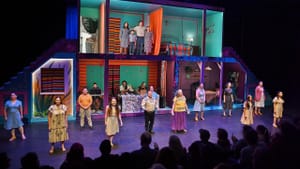Stay in the Loop
BSR publishes on a weekly schedule, with an email newsletter every Wednesday and Thursday morning. There’s no paywall, and subscribing is always free.
Capturing Philly’s Mexican American experience
Teatro Esperanza presents Tanaquil Márquez’s NICHOS

NICHOS, an ambitious high-concept theatrical experience, is getting its world premiere with Teatro Esperanza at North Philly’s Esperanza Arts Center. Written and directed by Tanaquil Márquez, this interdisciplinary, trilingual (English, Spanish, and Nahuatl) show portrays the Mexican American experience based on interviews and oral histories with Philly’s migrant community and their families in Mexico, alongside lush cultural elements.
I'm not an expert in Mexican culture, but I did study abroad in Veracruz for four weeks and visited Cozumel as a graduate student. My college Spanish is passing as best. But, I leaped at the chance to review NICHOS and experience its cultural immersion.
Through many chapters split across two acts, the play follows the familial experiences of Lola, an up-and-coming chef who migrated secretly to the States; Esperanza, a local activist; and Nacho, a Mexican American dealing with urban conflicts. The play is frequently interspersed with Indigenous mythical figures such as Quetzalcóatl, the Warrior Popocatepetl, and Princess Iztaccihuatl, as well as the personification of Magic and the Wind.
Fantastical successes
The show’s greatest strength is the set by Michael Lambui and muralist Calo Rosa. Lambui and Rosa create a living Nicho box as a house with aqua and fuchsia stylings on the steps and avocado-green and lavender-purple walls with pops of orange studded by foil figurines. The mythical creatures costumed by Rebecca Kanach are also standouts, including the sequined tail feathers of Magic (Chapter 8) and the ribboned streamers surrounding Balam (Manuel Vasquez) as the Wind in Chapter 15.
Other fantastical elements are equally enticing. Kudos to Alejandro Utria for bringing Quetzalcóatl’s otherworldly personae and magnificent headdress to life. The dancing cacti, the glowing womb, the slow-motion balloon effect simulating gunfire, the three cultural dancers, the women’s rights demonstration, and the cast’s musical talents all add elements of whimsy. I especially enjoyed the way Ampersan (a band from Mexico City providing original music) circulated through the set as cast members or individual musical figures. Shout out to actor Victor Rodriguez for perfectly portraying every racist figure possible while embodying beautiful vocal capabilities.
An overstuffed story
The script itself feels overfull, even to someone with minimal Spanish skills. This show’s ambitious scope reminds me of Passage Theatre’s recent Ghetto Gods in Divineland, which addressed gentrification and generational trauma through magical roots, prejudiced authority figures, and god-like characters while incorporating music, dance, and multimedia displays. Such rich cultural sources demand some selectivity in what is portrayed onstage, or some of it will get lost.
With about 18 chapters and 21 cast members playing at least two characters each, the show needs some edits. In addition to the key stories of Lola, Esperanza, and Nacho, Márquez includes one-off interludes of others who also experienced violence.
Sometimes, the play luxuriates in the performative melodrama of assault. I have criticized directors who sweep over abuse, but Márquez over-marinates in it. The choreography of a woman strangled by her boyfriend is beautiful but excessive and continues for several minutes. A previous chapter sufficiently showcases Lola’s experience with racism; the brutalization of her daughter and an additional family tragedy are not necessary to evoke more sympathy.
More development needed
The script falls short in other areas. Lola’s relationship with her husband Fitu is underdeveloped: despite a gorgeous early family scene, we never actually see the two sit down and communicate their love sans the comedic bells and whistles of love triangles. This undercuts the feeling of Fitu’s exile. A quiet moment between Nacho and Balam in Act One feels more genuine than simulated gang violence. The play’s core narratives need more space and fewer dramatics to unfold.
Sold out for good reason
This run is currently sold out, and I can understand why: it’s worth seeing. Crucially, Márquez highlights truths that have fallen out of mainstream media coverage, including the physical and sexual assault of children and adults by US authority figures during migration. Parts of the primarily Spanish first half are translated, so the show is accessible to locals who don’t speak Spanish, but notable for the rarity of Philly theatrical offerings in Spanish. The show could have benefited from professional actors for the more nuanced parts, but using amateur actors makes the play more accessible to its audience, especially those of school age. And when was the last time you saw a band from Mexico City play in a life-sized Nicho box?
What, When, Where
NICHOS. Created, written, and directed by Tanaquil Márquez; music directed by Ximena Violante and murals by Calo Rosa. $15; free for students and seniors. Through October 27, 2024, at Esperanza Arts Center, 4261 North 5th Street, Philadelphia. (215) 324-0746 or esperanzaartscenter.us.
Accessibility
Esperanza Arts Center is a wheelchair-accessible venue with general admission seating, but guests with specific accessibility needs should contact the box office in advance.
Sign up for our newsletter
All of the week's new articles, all in one place. Sign up for the free weekly BSR newsletters, and don't miss a conversation.
 An Nichols
An Nichols